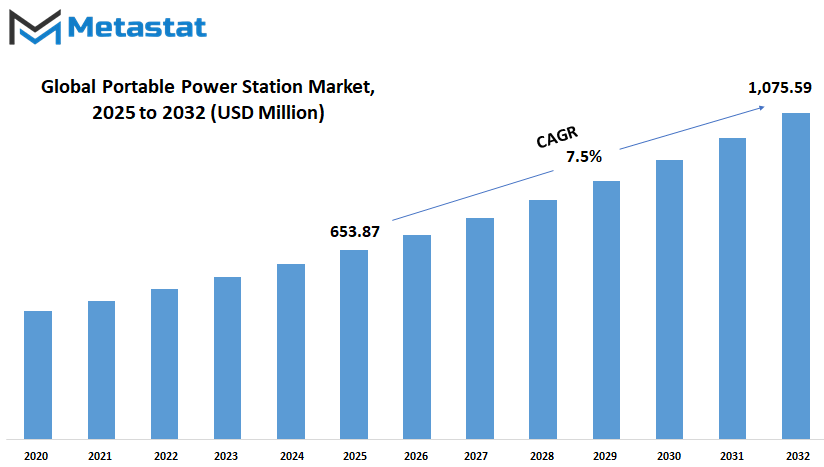MARKET OVERVIEW
The global portable power station market, falling under the category of off-grid power solutions and energy storage industries, will evolve as a niche business fulfilling the need for portable, rechargeable, and compact sources of energy. The industry will offer solutions for transient, mobile, and emergency power needs in different environments, such as outdoor recreation, residential backup, and professional field work. Since the demand for portable power increases beyond conventional fuel-fired generators, this segment shall provide alternative solutions that are greener, quieter, and more responsive to power requirements of today.
The global portable power station market products shall vary in capacity and functionality, generally incorporating lithium-ion or lithium iron phosphate battery systems with applications in powering or charging electronic devices, tools, appliances, and communication equipment. These stations will also include items like inverters, solar charge controllers, AC/DC outputs, and digital interfaces to allow users to track use and tailor their energy output to meet particular needs. Portability will be the primary design consideration for these stations, so they are easy to transport, have rapid recharge cycles, and are simple to use, whether installed in remote work sites or used for recreational purposes in off-grid settings.
The market will find applications from a broad range of end-users. Van-life enthusiasts, hikers, and campers will use small models due to their convenience and quiet operation. Professionals in emergency services, events, and construction will, on the other hand, be looking for larger units that offer reliable performance under heavy use. Families in areas that experience power losses or unstable grids will also appreciate these devices as a secure source of backup power. The range of user applications will inform product development, providing room for differentiation based on power capacity, weight, ruggedness, and charging methods.
Manufacturers and suppliers in the global portable power station market will have to deal with a highly technical environment. Certification needs for battery safety, electromagnetic compatibility, and environmental regulation will differ by region, necessitating customized approaches to international distribution. Supply chains will be determined by the production sourcing of critical battery materials, such as lithium and rare earth, creating yet another level of operational complexity. In addition, alliance building with solar panel producers and consumer electronics manufacturers will become more prevalent as organizations attempt to provide bundled power solutions.
Technology innovation will increasingly determine the competitive advantage in this industry. Incorporating rapid-charging algorithms, temperature control systems, and battery pack modules will condition how products are designed and promoted. The potential to be paired with smartphones or other electronic devices for real-time monitoring and remote operation will represent a differentiator factor for newer versions, particularly for consumers emphasizing automation and efficiency.
Distribution and retail channels in the global portable power station market will also vary based on geography. E-commerce sites and specialty electronics stores will drive channel strategy in developed economies, while utility outlets and local distributors will have greater prominence in emerging economies. Through direct consumer platforms or commercial arrangements, the market will increasingly extend its reach to multiple use cases and customer segments and serve them with customized power solutions in a convenient package.
Global portable power station market is estimated to reach $1,075.59 million by 2032; growing at a CAGR of 7.5% from 2025 to 2032.

GROWTH FACTORS
The global portable power station market is slowly emerging as an indispensable component of how individuals power their lifestyles, particularly when a reliable electricity supply is not always in place. With increasing numbers of individuals seeking backup power supplies during unplanned outages or to use outdoors, demand for portable power stations is increasing consistently. The products are no longer niche products for outdoorsmen or travelers. Rather, they are increasingly being regarded as a viable solution for daily applications, especially where grid connectivity is limited or the frequency of electricity interruptions is high.
Among the fundamental reasons individuals are resorting to portable power stations is that they are capable of facilitating cleaner energy habits. Greater numbers of users prefer these battery-operated systems in place of conventional fuel generators, primarily because they are quieter, safer, and greener. This transition to greener alternatives is also being prompted by the increase in awareness regarding lower carbon footprints. With individuals becoming more aware of the footprint they leave on the environment, there is a likelihood of increased preference for devices that can be charged from renewable means, such as solar panels. The transition towards solar integration, particularly with quicker charging speeds, is already dictating the direction of future advancements in this area.
Nevertheless, there are certain aspects that can slow down the growth of the market. One of the greatest challenges is the expense of advanced models. Devices that provide great storage capacity and fast charging tend to have a price that not every consumer can easily pay. Aside from this, there are issues regarding the amount of power these stations can deliver to heavy-duty equipment and how long their batteries will last when put under pressure. What this indicates is that although they are wonderful for light to moderate usage, they are not yet fully capable of handling the needs of users who need more powerful and consistent output.
Despite these constraints, there are tangible indications that the future of the global portable power station market is bright. The ongoing trend towards improved solar compatibility and fast charging capabilities will most likely appeal to more customers in the long term. As technology gets better and prices gradually decrease, these stations may become a standard component of how individuals maintain their energy supplies, at home, on the move, or where traditional energy resources are inadequate.
MARKET SEGMENTATION
By Type
The global portable power station market will keep on increasing steadily as the demand for reliable, portable sources of power grows across the world. With people and industries using electronic devices more and more for communication, work, and life during emergencies, the need for small and portable power solutions grows dramatically. Whether for use outdoors, backup during outages, or for people who live in areas where electric supply is uncertain, portable power stations are becoming the ubiquitous solution. With use increasing, so does innovation in how these units operate and what kind of energy they store. Where type is concerned, the global portable power station market will have significant variations in growth.
Lithium-ion compact power packs will probably lead the way in terms of popularity. They are lighter in weight, quicker to charge, and more enduring than others, making them an ideal selection for daily use and travel. Their efficiency also creates less need for replacement batteries and will deliver faster charging times for consumers. However, their cost may nevertheless be higher than alternatives, affecting judgments in more cost-sensitive areas. Lead-acid portable power packs, on the other hand, weigh more and charge slower. But are extremely rugged and less expensive. Where weight or charging time is less significant than cost, this model will remain. Those who need something tough for tough use might still utilize lead-acid models. Solar-powered portable power stations are also in the limelight for their ability to charge without fuel or wall outlets. With the improvement of the solar panel efficiency and the falling cost, these stations will definitely attract people who seek cleaner and more independent energy solutions. They can serve as a fine camping, off-grid, or emergency kit solution, especially when paired with small foldable solar panels.
Gasoline-powered portable power stations might not be as common in the long run because of noise and pollution problems. Nevertheless, they still enjoy a superiority in certain uses where uninterrupted power for extended durations is a requirement and fuel is easily available. In the long run, though, the trend will shift from gas-based products to cleaner and quieter technologies.
The future holds advances in battery storage, integration with solar, and smart controls that will shape the future of the global portable power station market. Advances in these areas will simplify power stations, improve efficiency, and widen their acceptance both in consumer and business applications.
By Power Capacity
The global portable power station market will keep on expanding as individuals globally call for simpler access to electricity, particularly when they are out of reach of conventional power resources. Whether for outdoor activity, in times of emergency, or while on the move, the demand for clean and reliable power has never been greater. With advancing technology and the energy-saving nature of devices, these power stations will be central to powering a lifestyle that is greatly reliant on gadgets and electronics.
By considering the market in terms of power capacity, we can more clearly see how individuals utilize these devices and what they are looking for from them. Models with power under 500Wh are typically selected for light applications. They are adequate for charging a phone, small light, or camera. They are favored due to their portability and ease of carrying. These small units will continue to be utilized by individuals who require immediate and easy power solutions.
Conversely, power stations that sit between 500Wh and 1000Wh are better for users seeking balance between portability and extended power. These devices can power small appliances and provide backup during short power outages. While more consumers are looking into off-grid living or flexible travel, this middle range will see increased interest. Individuals will seek dependable backup power without the sense of it being too heavy or too complex.
Power stations over 1000Wh are for individuals who require more power for a longer duration. They are convenient for use in backcountry employment or as a backup source in case of an emergency. As weather conditions change and cities expand, more individuals will desire backup power they can depend on. Greater power stations can power a variety of devices simultaneously, so they are great for home and outdoor use.
In the future, the global portable power station market will be defined by increased interest in renewable power and cleaner technologies. Users will prefer to recharge their stations from solar panels or similar equipment, less energy from fuel. This will compel manufacturers to create smarter, more efficient devices. The market's future will not only be defined by power output but also by convenience, cleaner charging technology, and reliable performance.
As life becomes more linked on a daily basis, portable power stations will discreetly enable many of the devices and routines individuals depend upon. They will become increasingly influential in everyday life, determining how humans consume energy in adaptive and dependable means.
By Application
The global portable power station market will experience considerable growth as technology continues to evolve and people demand more convenient sources of power. Portable power stations are becoming indispensable devices across industries due to the convenience they provide in storing and utilizing energy without relying on conventional power sources. Such convenience has popularized them for use in many applications, ranging from day-to-day operations to more strenuous industrial environments.
One of the biggest fields of development in this industry will be mobile device charging. As individuals become increasingly dependent on smartphones, tablets, and other portable devices, the market for convenient and readily available power solutions will increase. Portable power stations offer a means for consumers to charge their devices anywhere they may be, whether camping, on the go, or during an electrical outage. This portability results in people being less concerned about battery depletion, which is essential in today's interconnected environment. The tech on these power stations will get better over time, allowing them to be lighter, more efficient, and charge devices more quickly.
Another significant use is backup power for appliances. Power loss can cause inconvenience in day-to-day life, from lighting to vital household appliances. Portable power stations will be good backup sources in such moments, powering essential appliances. With more households embracing smart technology and using electric appliances, having a portable power source will become increasingly important. Future designs will offer higher capacity and longer running time, providing viable solutions for emergency readiness.
Industrial and commercial utilization will also fuel the growth of the global portable power station market. Most industries require solutions with power that is easily transportable and yields energy where conventional power is lacking. For construction workers, outdoor event professionals, or those in the field, portable power stations will provide a reliable means to power equipment, tools, and communications equipment. Enhancements in battery technology and energy management will enable such stations to support heavier workloads and last longer, accommodating more intensive work conditions.
In the future, the global portable power station market will keep evolving in the direction of making power more convenient, efficient, and friendly to the environment. The growing dependence on portable and backup power solutions will define how individuals and businesses address their energy requirements, driving innovation and increasing the scope of the market. This expansion will indicate the need for having power anywhere there is a need, without the loss of convenience and efficiency.
By End-Users
The global portable power station market is attracting interest as more individuals look for dependable and easy power solutions for different conditions. Portable power stations provide an adaptable means to provide electricity where conventional power channels might not be found or be convenient. This has resulted in them finding growing application through various categories of end-users, each with specific needs that fuel the demand for them.
In homes, portable power stations will be an ordinary aspect in most homes. They will be used to supply critical devices during power outages or when off the grid. The convenience and capacity to store energy will make them an easy option for daily emergencies or simple backyard relaxation. With homes becoming increasingly smart with more electronic devices, backup power will be needed more and more, and portable power stations will become the norm for home readiness.
Outdoor users will also see much benefit from developments within this industry. Camping and hiking, among other outdoor activities, will experience increased demands for light, efficient portable power sources that can power multiple devices. The consumers will seek longer lasting stations that charge fast to ensure that they can use their devices for the entire duration of their journey. Portable power stations that are designed for the outdoor market will create new avenues of exploration without fear of losing access to communication and navigation technologies.
Preparation against emergencies and disasters will also be another category where the market will grow enormously. Natural disasters and surprise power outages emphasize the need for a good backup power source that can be easily installed. Portable power stations will become necessary for safety and communication during such occurrences. Their capacity to supply power for essential devices such as medical equipment, radios, and lighting will make them a vital component of home and public safety emergency kits.
In business use, portable power stations will continue to serve industries that need mobility and flexibility in their source of power. Companies like construction, event planning, and remote operations will utilize these stations to sustain productivity where conventional power sources are not accessible. The ease of moving and installing power stations will fuel demand in this market, enhancing companies' ability to perform in harsh environments.
In the future, the global portable power station market will advance with advancements in technology, which will make portable power stations more efficient, affordable, and convenient. The increasing emphasis on clean energy and sustainability will also dictate the future development of portable power solutions, promoting the integration of renewable energy sources. In general, this market will experience further growth under the influence of the varied needs of residential, outdoor, emergency, and commercial users needing reliable power wherever they are.
|
Forecast Period |
2025-2032 |
|
Market Size in 2025 |
$653.87 million |
|
Market Size by 2032 |
$1,075.59 Million |
|
Growth Rate from 2025 to 2032 |
7.5% |
|
Base Year |
2024 |
|
Regions Covered |
North America, Europe, Asia-Pacific, South America, Middle East & Africa |
REGIONAL ANALYSIS
The global portable power station market is anticipated to undergo tremendous transformations in the near future, led by the increasing need for efficient and reliable power sources across most regions of the globe. As individuals look for substitutes to conventional energy sources, portable power stations provide a convenient option, particularly in regions where electricity is not readily available or power supply is unstable. These appliances are becoming a necessity for outdoor recreation, emergencies, and even general use, symbolizing a change in the way energy is used and controlled.
Considering various regions, the market will evolve differently based on regional conditions and demands. In North America, the U.S., Canada, and Mexico will likely be at the forefront of adoption because there is broad interest in renewable energy and increasing investments in technology. The portability of power stations will appeal to lifestyles that emphasize mobility and readiness, so this region is a driving force to define the future of the market.
Europe is another region to watch, where nations such as the UK, Germany, France, and Italy are likely to contribute towards consistent growth. The focus on lowering carbon footprints and raising energy efficiency will propel demand for portable power stations. These nations are already promoting innovations for cleaner energy solutions, and portable power stations naturally fall into place with this, particularly for consumers seeking backup power or off-grid scenarios.
It is much more diversified in Asia-Pacific. Countries like China, India, Japan, and South Korea will experience varying growth rates depending on their economic development and energy demands. For example, those with high rural population density might find power stations particularly handy to supply power to places where infrastructure is still not well established. On the other hand, more developed urban areas might emphasize integrating these power stations into intelligent energy systems to assist sustainable living.
The market of South America, including Brazil and Argentina, will also grow based on the necessity of secure electricity during frequent power outages and increased demand for outdoor and recreational activities. The Middle East and Africa, including the GCC nations, Egypt, and South Africa, will experience increased adoption of portable power stations because of the pair of challenging weather and the necessity for power in off-grid locations. These areas will be of greater importance as they embrace more technology in order to facilitate everyday living as well as emergency preparedness.
Overall, the global portable power station market will be influenced by a larger trend toward self-sufficiency from fixed electricity grids and a shift towards cleaner, more flexible energy solutions. With improving technology and decreasing costs, more individuals globally will rely on such devices, and the market will be a prime area of growth and development in the near future.

COMPETITIVE PLAYERS
The global portable power station market will continue to grow consistently as individuals seek out dependable power sources that can be utilized anywhere. Increasing numbers of people are enjoying the outdoors, going out in vehicles that are powered by electricity, or telecommuting in environments where standard plug-in facilities are not found. Consequently, the demand for portable and rechargeable power sources will keep growing. These portable power stations provide a cleaner, quieter option compared to conventional generators and are thus more desirable for both personal and business applications. Because they are rechargeable via solar panels, wall chargers, or car chargers, they provide users with a variety of options based on their requirements.
Numerous companies are actively developing the quality and features of these power stations. Major companies present in the global portable power station market include EcoFlow Japan Co., Ltd., Jackery Japan Inc., Anker Japan Co., Ltd., Goal Zero Japan, Bluetti Power Japan, Westinghouse Electric Japan, ELECAENTA Japan, Omnicharge Japan, Renogy Japan, Aimtom, Rockpals, Scott Electric Corporation, Bluetti, and Drow Enterprise. These brands are concerned with producing devices that not only are light in weight and easy to transport but also are capable of generating enough power to charge devices like phones, laptops, lamps, and even appliances. In time, these brands will continue to incorporate additional features like higher speed charging, longer battery duration, and more robust safety features to safeguard users and devices.
In the future, the global portable power station market will gain significance as individuals attempt to cut back on fossil fuel usage. During natural disasters or in situations of emergency, these power stations offer a reliable backup when the normal power grid collapses. With more individuals becoming conscious of climate issues and looking for greener alternatives, solar-powered models are expected to be in greater demand. Additionally, as battery technology improves, more powerful yet more compact stations that last longer on a charge are to be expected.
Additional industries will also start utilizing these stations for job sites, events, and outdoor operations, where they will have a need for power but may not be readily available. With features such as app control and digital displays becoming standard, operating these devices will only be more convenient. In the coming years, this market is sure to witness increased collaborations between energy companies and technology companies to develop smarter, more connected systems that can cater to a variety of needs. All this indicates huge potential for the global portable power station market in the coming years.
Portable Power Station Market Key Segments:
By Type
- Lithium-ion Portable Power Stations
- Lead-acid Portable Power Stations
- Solar-powered Portable Power Stations
- Gasoline-powered Portable Power Stations
By Power Capacity
- Below 500Wh
- 500Wh to 1000Wh
- Above 1000Wh
By Application
- Mobile Device Charging
- Backup Power for Appliances
- Industrial and Professional Use
By End-Users
- Residential
- Outdoor Activities (Camping, Hiking, etc.)
- Emergency and Disaster Preparedness
- Commercial
Key Global Portable Power Station Industry Players
- EcoFlow Japan Co., Ltd.
- Jackery Japan Inc.
- Anker Japan Co., Ltd.
- Goal Zero Japan
- Bluetti Power Japan
- Westinghouse Electric Japan
- ELECAENTA Japan
- Omnicharge Japan
- Renogy Japan
- Aimtom
- Rockpals
- Scott Electric Corporation
- Bluetti
- Drow Enterprise
WHAT REPORT PROVIDES
- Full in-depth analysis of the parent Industry
- Important changes in market and its dynamics
- Segmentation details of the market
- Former, on-going, and projected market analysis in terms of volume and value
- Assessment of niche industry developments
- Market share analysis
- Key strategies of major players
- Emerging segments and regional growth potential








 US: +1 3023308252
US: +1 3023308252






